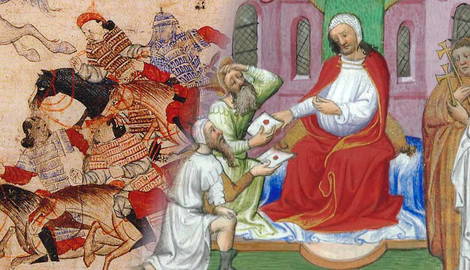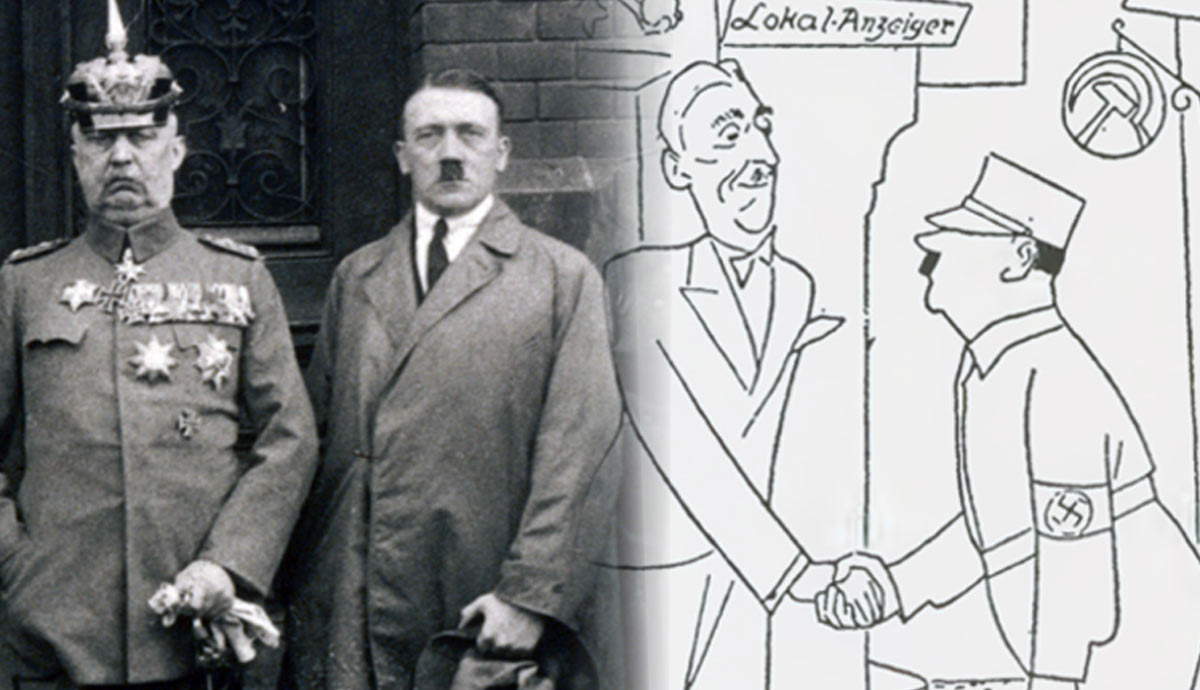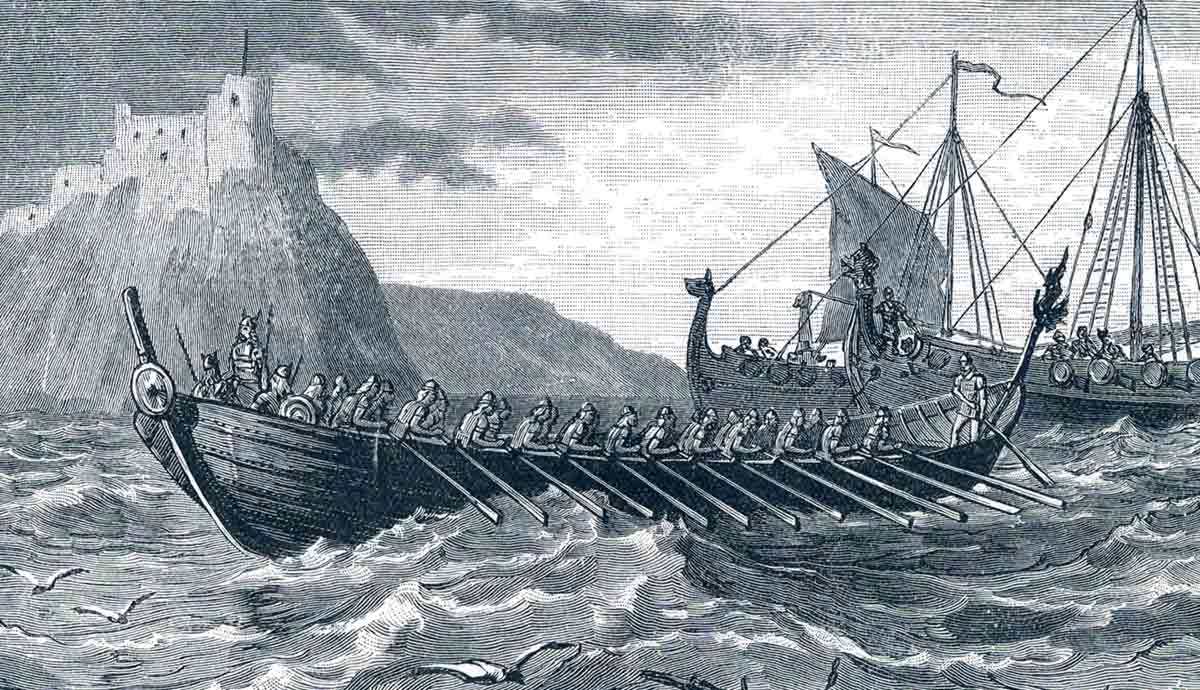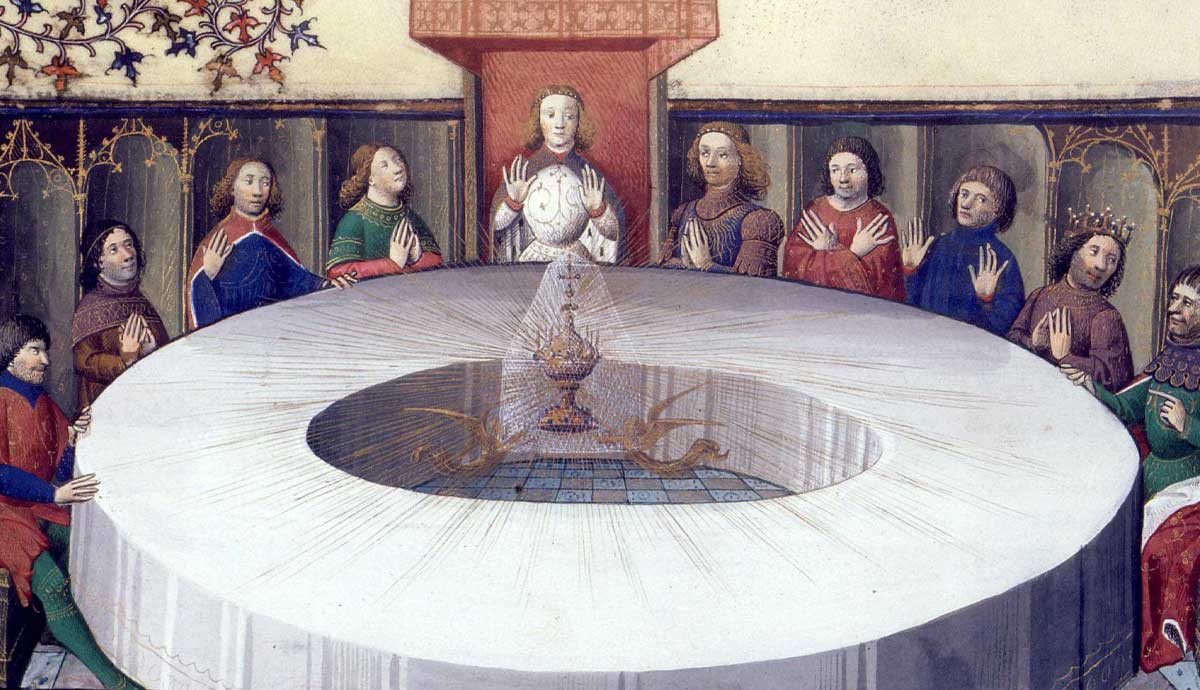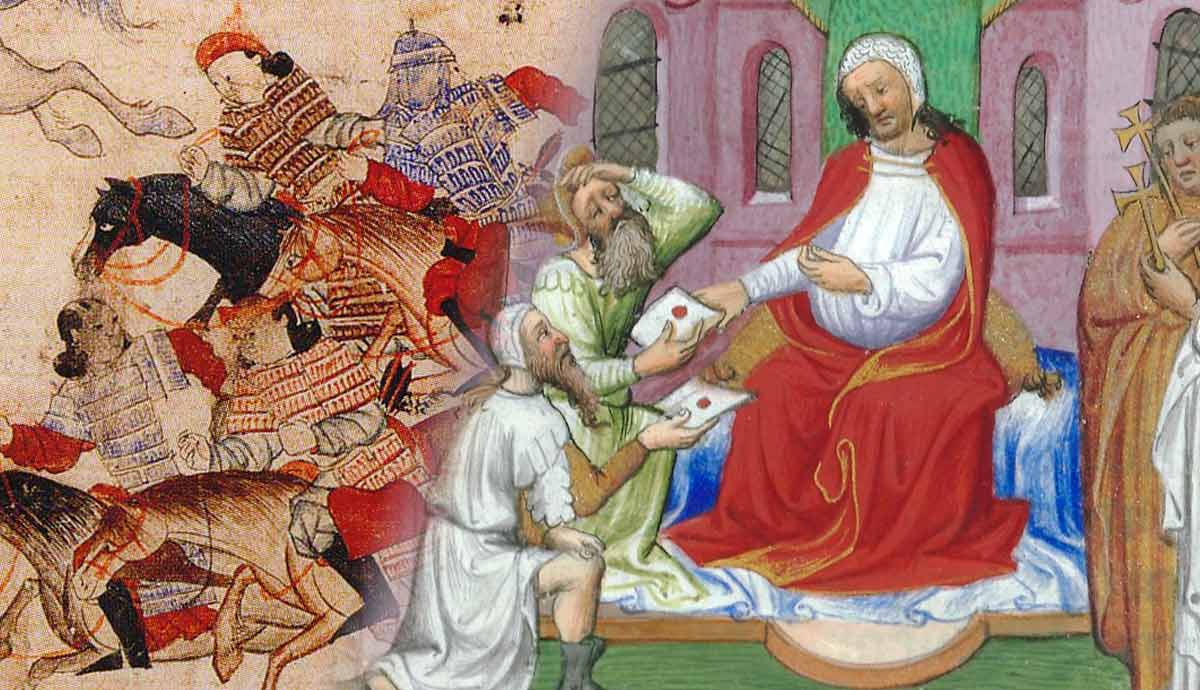
The Church of the East was already present among various Mongol tribes when Kublai Khan (1260–1294) conquered China. Though they were not the majority among Mongols, the Church of the East managed to spread among the nobility and even some Mongol rulers. After Kublai Khan’s conquest, the Church of the East restored Christianity in China. However, it soon lost the goodwill of emperors who turned to traditional Chinese religions and came into conflict with the Roman Catholic Church. After the fall of the Yuan Dynasty in 1368, new emperors from the Ming Dynasty expelled all foreign religions, including the Christians.
Mongol Conquest of China

Shortly after the fall of the Tang Dynasty in 907, nomadic peoples from Central Asia founded states and dynasties in the northern parts of China. China’s new dynasty, the Song (960–1279), failed to confront these nomadic peoples and bring them under control as the Tang rulers had done.
The Jurchens, originally from eastern Manchuria, conquered large areas of northern China and even captured the Song capital. Their rulers, who quickly assimilated into Chinese culture, founded the Jin dynasty (1115–1234). Neither they nor other non-Chinese dynasties were able to establish control over the Central Asian steppe. Only Genghis Khan (1206–1227) managed to conquer all the peoples of Central Asia, establishing one of the largest empires in history. After his death, his empire was divided. His third son, Ogödei, conquered the Jin Dynasty and thus brought the Mongols to the border of southern China, under the rule of the Song Dynasty.

During the time of Kublai Khan (1260–1294), the conquest of the southern Song Dynasty began, which was completed by 1279. Kublai Khan moved his capital from Mongolia to Beijing and took the Chinese name Yuan as the name of his dynasty. His descendants ruled as emperors of China until 1368.
Although controlled by a foreign dynasty, the de facto Chinese Empire continued to exist. The Mongols only represented a minority that ruled the state. Ethnic tensions did exist, but Chinese cultural life continued as normal, and the Chinese were not forced to adopt the culture of their conquerors. Yuan Dynasty rulers promoted internal and external trade and continued to use Chinese money.
In spite of never being fully sinized, the Yuan emperors adopted many Chinese customs and performed many rituals that stemmed from Chinese tradition. Kublai Khan and his successors inherited from the previous Chinese dynasties the universalistic tendencies that arose under the influence of Confucianism.
Christianity Among the Mongols

The Church of the East, which has its origins in the Syriac communities of the Sasanian Empire, carried out great missionary activity in Central Asia during the Early Middle Ages. The members of this Church were often called “Nestorians,” which modern authors consider to be wrong. However, for the sake of clarity and for practical purposes, that name will be used in this article as well.
The monks of the Church of the East were skilled in foreign languages and succeeded in preaching Christianity among various Turko-Mongol peoples. Their success, among other things, is the result of their openness to syncretism, that is, the acceptance of elements from the native religions of other peoples. Already in the 7th and 8th centuries, a small community of Uighurs had received Christianity from Syrian monks. In the following centuries, Nestorian Christianity spread among various Turkic and Mongol tribes.

The Keraite people, who lived southeast of Lake Baikal, converted to Nestorian Christianity at the beginning of the 11th century, supposedly around 1007. Their conversion to Christianity is attributed to the monk Mar Sergius from Samarkand, who is revered as a saint in the Church of the East.
Christianity remained for a long time among the Keraites — at least among their nobility. At the end of the 12th century, they became the most powerful Mongol nation under the leadership of Gur Khan Toghril (1260s–1201), who was supposedly a Christian. His ancestors bore Christian names — his father’s name was Qurjaguz (Cyriacus), and his grandfather’s was Marghuz (Mark).
The Mongol prince, Temüjin, later known as Genghis Khan, was a vassal of Toghril for many years after his father was killed by the Tatars. His camp was then located in Ulaanbaatar, where the Nestorian priests had a church in a tent. When Temüjin became Khan in the 1180s, he remained Toghril’s ally for a long time. He helped him defeat the Naiman people, who were also Nestorian Christians. However, at the beginning of the 13th century, there was a conflict between the two in which Genghis Khan prevailed.
Toghril Khan became one of the influences on the legend of Prester John, the mysterious Christian king from the East.

In the neighborhood of the Keraites lived several other Mongolian peoples who converted to Nestorian Christianity, such as the Oriates and the Merkits. The Mongol peoples living in Manchuria were also converted under the leadership of Prince Nayan (third quarter of the 13th century), who was related to Kublai Khan. Nayan rose against Kublai Khan in 1287. The famous Marco Polo testified about this conflict. Kublai Khan personally led the army into Manchuria and defeated Nayan, after which he executed him.
Allegedly, Nayan’s army carried war flags depicting the cross during the battle. Among the most powerful Nestorian Mongols were the Ongüts. They lived in the northern valley of the Yellow River, between the Gobi Desert and the Great Wall of China. At the beginning of the 13th century, they sided with Genghis Khan and became his important allies. The Nestorian ruling house of Ongüts was closely related by family ties to the Mongol imperial house. The Nestorian monk Rabban Markos was born in the Ongüt capital of Kwashang and later became the Patriarch-Catholicos of the Church of the East under the name Yahballaha III (1281–1317).
Many Ongüt rulers bore Christian names, such as Görgüz (George), whom Marco Polo says was a descendant of Prester John. Görgüz was a powerful and influential ruler, whose first wife was the granddaughter of Kublai Khan and the second daughter of Timur (Chinese emperor, 1294–1307).
Church of the East During the Yuan Dynasty (1271–1368)

Though the Church of the East was widespread in China during the Tang Dynasty, Christians completely disappeared from China during the second half of the 9th century. After the Mongol conquest of China in the second half of the 13th century, the Church of the East re-established its organization in China. From the time of Kublai Khan (1260–1294), more Nestorian Christians appear in Chinese documents.
During his reign, the Church of the East enjoyed many privileges. Among other things, it was exempted from paying taxes. In 1289, an office for Christian affairs was established. At Kublai Khan’s court, there were many Christians who held influential and significant positions. The most important of them was the Syrian astronomer and physician Isa (Ai Xieh, c. 1227–1308). Kublai Khan first put him in charge of the office for medicine and astronomy. Isa also had a rich diplomatic career; in 1284, he was sent to Baghdad to serve as a translator for a delegation sent to Arghun Khan. After that, he went on a diplomatic visit to Pope Honorius IV (1285–1287) with a letter from Kublai Khan in which the Khan offered the Pope an alliance against the Mamluks in Egypt. On his return, Isa was appointed commissioner of the office for the Christian religion from 1291, and from 1297 he was minister of state.
Mar Sargis, who was vice-governor of the strategically important Zhenjiang district from 1277 to 1283, also had a great influence. In that district, Mar Sargis built six Christian monasteries, as well as another one in the port city of Hangzhou.

As early as 1248, Beijing became the center of the bishopric, and from 1275, it became the center of the archbishopric headed by Metropolitan Mar George. In the years that followed, the organization of the Church of the East expanded even more. The edict from 1315 mentions as many as 72 dioceses in China. Certain dioceses, especially those that were linked to nomadic Mongolian tribes, were not linked to specific cities.
Regardless of these facts, Christians in China, as in the Tang Dynasty, were mostly non-Chinese and were viewed as foreigners. This can be seen very well in the example of the already-mentioned Zhenjiang district. According to the census of 1331, the number of Christians in Zhenjiang was only 215 out of a total of 636,500 inhabitants, or 0.033%. In the census, they are categorized as “foreigners” or immigrants.
One of the reasons why the Church of the East did not spread among the Han Chinese was probably the use of the East Syriac language for liturgical purposes, which even many followers of the Church did not understand.

Though they were few in number and limited as foreign settlers, the Nestorian Christians had many influential and important people in their ranks, especially during the reign of Kublai Khan. The reason for this lies in the very division of Chinese society during the Yuan Dynasty. This social division, introduced by Kublai Khan after 1279, consisted of four classes: at the very top were Mongols, then foreigners (Central Asians and Iranians), northern Chinese, and finally southern Chinese. Nestorian Christians were predominantly in the first two classes, which is the reason for their large presence in the state administration.
The testimony of John of Cora, the Latin bishop from Iran, speaks of the wealth of Nestorian Christians in China. He wrote around 1330: “These Nestorians are more than thirty thousand in China. They have very beautiful and orderly churches with crosses and images in honor of God and of the saints.”
Final Demise

In 1278/1279, two monks, Rabban Bar Sauma and his disciple Marcos, set off from Beijing on a pilgrimage to Jerusalem. Shortly after their return in 1281, Marcos became the new Patriarch-Catholicos of the Church of the East under the name of Yahballaha III.
At the request of the Mongolian Ilkhanate ruler Arghun, Yahballaha III sent his former teacher Rabban Bar Sauma around 1287, on a diplomatic trip to Europe. Over the next few years, Rabban Bar Sauma visited many European courts and stayed with Pope Nicholas IV. Ironically, the result of these trips was a weakened position for the Church of the East in China. When the Pope learned of the existence of Nestorian Christians in China, he sent the Franciscan missionary John of Montecorvino, who arrived in China around 1294.
Montecorvino soon began work on converting the Nestorians to Roman Catholicism, which further weakened the position of the Church of the East in China. King George of Ongüts, who until then was the most important Nestorian, converted to Roman Catholicism. As early as 1307, the Pope named Montecorvino as the archbishop of Beijing.
In this way, the Roman Catholic missionaries entered into an open conflict with the representatives of the Church of the East, which they considered heretical. Inter-Christian conflicts only further alienated the native Chinese population from Christianity. Both Christian currents were viewed by the Chinese as foreigners — the Nestorians as Mongols, and the Roman Catholics as Europeans.

After Kublai Khan’s death, his successors were not as sympathetic to Nestorian Christians as he had been during his reign. For example, in 1304, the Taoists of Zhenjiang accused the Nestorians of converting Taoists to Christianity south of the Yangtze River. The public court ruled in favor of the Taoists, and the Christians were deprived of priority in the public confession of religion in the above-mentioned area. Buddhist monks from Zhenjiang also rebelled against the Nestorians.
Around 1311, Emperor Buyantu (1311–1320) proclaimed two edicts directed against Christians. All of the Nestorian monasteries in Zhenjiang had to be converted into Buddhist temples. In the middle of the 14th century, Mongol rule in China began to gradually weaken. During the reign of the last Mongol emperor of China, Toghan Timur (1333–1368), anti-Mongol rebellions broke out.
The result of these rebellions was the expulsion of the Mongols from China and the establishment of the new Chinese Ming Dynasty in 1368. Unlike the Yuan Dynasty, which was much more open to the outside world, the Ming Dynasty pursued an isolationist policy and opposed all foreign elements in China. The new rulers ordered the expulsion of all foreign monks and the demolition of their religious buildings.
The last Nestorian Christian graves and tombstones that we know of date from the 1330s and 1340s. By the end of the 14th century, Nestorian Christianity had disappeared from China for the second and final time.
